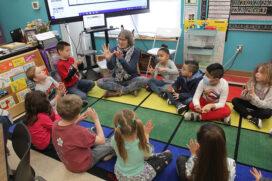The free, weekly meditation class led by Dan Barnes at Socorro Public Library offers 30 minutes of stillness to start the day.
People often mystify meditation, Barnes tells his class, but the bells and whistles are secondary. They are meant to lead you to the point of your own awareness.
“A mechanic meditates on engines all the time,” Barnes said.
That intense focus on enjoyment is a form of meditation available to anyone. The easiest way to meditate is right after waking up, when you are relaxed and inhabit the space between sleeping and waking — that’s meditation.
“That place is within us all the time,” said Barnes. “Meditation is reaching the place within us all the time.”
Meditation is a way to still the mind. Once the mind is calm, it can be focused. A focused mind can solve difficult problems. Fresh insights can come to a calm mind.
“The ancient image of a continuous flow of oil from one vessel into another has been used to describe meditation. In order to calm the restless mind, there must be a point to which one directs one’s attention. Meditation directs the flow of energy into one steady stream.”
Counting respiration rates can help calm the mind. Meditative breathing is long and slow breathing into the belly. It’s normal for other thoughts to intrude. Letting those thoughts go and returning focus to the moment and breathing is part of the practice.
Religious and spiritual traditions
Barnes sees meditative practices in many religious traditions, from praying the Rosary at San Miguel — a form of devotional meditation, to silently “sitting in the light” at Quaker meetings, to dwelling upon a specific Bible verse — passage meditation, to the sitting meditation practiced by Buddhists where one dives deep within to discover innate truth.
“Tibetans practice imaging meditation by sending out waves of compassion to a person they hold in the mind, a person to whom they wish to send loving kindness,” Barnes said. “First a friend is the recipient, then a neutral person, and finally an enemy receives these waves of tolerant mercy.”
Barnes points out that The Beatles practiced a form of mantra meditation, a method of inwardly intoning a holy syllable repeatedly.
“Awareness meditation means being aware of one’s own original being,” he said. “When we were born, we had no thoughts, yet we were aware. Returning to that simple perfect awareness can be done through meditation.”

Maureen Wilks practices a mindfulness technique with first-graders at Midway Elementary School in Socorro. The students breathe in as they trace up fingers on their hand and breathe out as they trace down. Cathy Cook | El Defensor Chieftain
Mindfulness at school
Maureen Wilks, a SCOPE Health Council volunteer, has taken classes on the Mindful Schools curriculum so she can teach it in local schools. She studied meditation in a nine-week course with Halli Bourne in 2017 that required at least 30 minutes of daily practice, and took an eight-week Compassion Cultivation Class (Stanford-CCARE) in 2019.
In 2020, Wilks completed the teacher training classes from Mindful Schools.
Wilks started the weekly mindfulness session with Rae Zuniga’s first-grade class by pulling a roadrunner plush toy out of her bag. She asked the students to practice their mindful looking, then describe what they saw. Black, brown and tan were popular answers, but one student even noticed the ring of blue around the roadrunner’s eyes.
The students also practiced mindful breathing, placing one hand on their heart or belly and focusing on their breath. Wilks directs them to think “thinking” if their mind begins to wander, then refocus on their breathing.
Wilks visits every Midway Elementary classroom for 15 minutes once a week to teach mindfulness. This semester, she’s also begun visiting Parkview Elementary in Socorro. She uses a Mindful Schools curriculum, which focuses on mindfulness of breath, of the body and sending kind wishes.
“It really starts to train them in the ability to focus,” Wilks says. “We’re always trying to tell children and adults to pay attention and no one ever teaches you actually how to pay attention.”
The practice can help alleviate anxiety, depression and chronic pain, and is helpful for stress management, she said. “It allows you to be comfortable with those feelings.
“One of those things with stress and anxiety is we push them away but pushing them away doesn’t allow them to move through us. It just builds.”
Being present can help you notice what anxiety feels like in the body.
“The other thing about anxiety, is we’re in our head. There’s a storyline and we get caught in it. In mindfulness, we focus on our breathing. It sort of cuts the dialogue.”
Mindful practices can help people better regulate their emotions.
“You don’t go into a practice to be calm,” said Wilks. “You go into a practice to learn to be with whatever emotion, whatever you’re feeling in the present moment.”
But learning to sit with uncomfortable feelings can help people be more relaxed and resilient overall. With children especially, learning to notice when they are becoming angry is a useful benefit of mindfulness. If they notice anger in their body, they can take a pause with a mindful breath. This can give them time to react differently.
“When you get to middle school, you see the anger really coming out and now we’re getting to the point where you see middle school and high school students showing up with guns, and a lot of it is to do with anger management issues,” said Wilks.
Wilks started teaching mindfulness because she saw the benefits in her own life, first to manage chronic pain in her hips and then to manage grief after her husband died.
“That was where I really moved into the practice of love and kindness,” she said.
Sending kind wishes means repeating kind phrases, “May I be happy,” first about yourself and then directed to a loved one, then a neutral person. With adults, that is also followed by directing the kind wishes to someone difficult.
At Parkview Elementary, kindergarten students have begun starting their mornings with kind wishes.
“It strengthens connections,” Wilks says. “It also means that children who are missing a family member, they express that, and they can work through the emotions of sadness and grief by expressing kindness and love to the people they miss.”






















